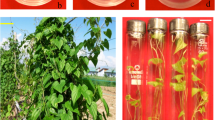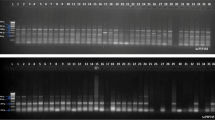Abstract
Field performance evaluation and genetic integrity assessment were conducted in Argyranthemum plants derived from cryopreserved shoot tips. Some variations in root formation and vegetative growth were found in the plants following cryopreservation, but morphologies of the leaves and flowers, and color, number and size of the flowers remained unchanged in the plants recovered from cryopreservation, compared with the control. Assessments of genetic integrity by the two molecular markers: inter simple sequence repeat (ISSR) and amplified fragment length polymorphism (AFLP) did not detect any polymorphic bands across the plants tested following cryopreservation. These data indicate that cryopreservation reduces, to a certain degree, root formation and vegetative growth, but it does not alter morphologies of leaves and flowers, may not cause any genetic alternations, and has no adverse effects on quantity and quality of the flowers. Therefore, the droplet vitrification cryopreservation can be considered promising for long-term preservation of Argyranthemum germplasm.



Similar content being viewed by others
References
Ahuja S, Mandal BB, Dixit S, Srivastava PS (2002) Molecular, phenotypic and biosynthetic stability in Dioscorea floribunda plants derived from cryopreserved shoot tips. Plant Sci 5:971–977
Ai PF, Lu LP, Song JJ (2012) Cryopreservation of in vitro-grown shoot-tips of Rabdosia rubescens by encapsulation-dehydration and evaluation of their genetic stability. Plant Cell Tissue Organ Cult 108:381–387
Aronen TS, Krajnakova J, Häggman HM, Ryynänen LA (1999) Genetic fidelity of cryopreserved embrogenic cultures of open-pollinated Abies cephalonica. Plant Sci 142:163–172
Ashmore SE, Drew RA, Kaity A (2011) Storage stability using cryopreservation: a case study in papaya. Acta Horticult 918:125–130
Benson EE (2014) Cryopreservation of phytodiversity: a critical appraisal of theory & practice. Crit Rev Plant Sci 27:141–219
Bornet B, Branchard M (2001) Nonachored inter simple sequence repeat (ISSR) markers: reproducible and specific tools for genome fingerprinting. Plant Mol Biol Rep 19:209–215
Brickell C (1999) Encyclopedia of garden plants. The Royal Horticultural Society, London
Castillo NRF, Bassil NV, Wada S, Reed BM (2010) Genetic stability of cryopreserved shoot tips of Rubus germplasm. In Vitro Cell Dev Biol Plant 46:246–256
Dice LR (1945) Measures of the amount of ecologic association between species. Ecology 26:297–302
Dresler-Nurmi A, Tereffework Z, Kaijalainen S, Lindström K, Hataokka A (2000) Silver stained polyacrylamide gels and fluorescence-based automated capillary electrophoresis for detection of amplified fragment length polymorphism patterns obtained from white-rot fungi in the genus Trametes. J Microbiol Meth 41:161–172
Elameen A, Fjellheim S, Larsen A, Rognli OA, Sundheim L, Msolla S, Masumba E, Klemsdal SS (2008) Analysis of genetic diversity in a sweet potato (Ipomoea batatas L.) germplasm collection from Tanzania as revealed by AFLP. Genet Res Crop Evol 55:397–408
Engelmann F (1997) In vitro conservation methods. In: Callow JA, Ford-Lloyd BV, Newbury HJ (eds) Biotechnology and plant genetic resources. CAB International, Oxford, pp 119–161
Hao YJ, Liu QL, Deng XX (2001) Effect of cryopreservation on apple genetic resources at morphological, chromosomal, and molecular levels. Cryobiology 43:46–53
Hao YJ, You CX, Deng XX (2002) Analysis of ploidy and the patterns of amplified fragment length polymorphism and methylation sensitive amplified polymorphism in strawberry plants recovered from cryopreservation. Cryo Letters 23:37–46
Harding K (2004) Genetic intergrity of cryopreserved plant cells: a review. Cryo Letters 25:3–22
Harding K, Staines H (2001) Biometric analysis of phenotypic characters of potato shoot tips recovered from tissue culture, dimethyl sulphoxide treatment and cryopreservation. Cryo Letters 22:255–262
Hirai D, Sakai A (1999) Cryopreservation of in vitro-grown meristems of potato (Solanum tuberosum L.) by encapsulation-vitrification. Potato Res 42:153–160
Jaccard P (1908) Nouvelles recherches sur la distribution florale. Bull Soc Vaud Sci Nat 44:223–270
Jokipii S, Ryynänen L, Kallio PT, Aronen T, Häggman H (2004) A cryopreservation method maintaining the genetic fidelity of a model forest tree, Populus tremula L. × Populus tremuloides Michx. Plant Sci 3:799–806
Kaity A, Ashmore SE, Drew RA (2009) Field performance evaluation and genetic integrity assessment of cryopreserved papaya clone. Plant Cell Rep 28:1421–1430
Kaity A, Drew RA, Ashmore SE (2013) Genetic and epigenetic integrity assessment of acclimatized papaya plants regenerated directly from shoot-tips following short- and long term cryopreservation. Plant Cell Tissue Organ Cult 112:75–86
Kulus D, Zalewska M (2014) Cryopreservation as a tool used in long-term storage of ornamental species—a review. Sci Hortic 168:88–107
Liu YG, Liu LX, Wang L, Gao AY (2008) Determination of genetic stability in surviving apple shoots following cryopreservation by vitrification. Cryo Letters 29:7–14
Mandal BB, Ahuja-Ghosh S, Srivastava PS (2008) Cryopreservation of Dioscorea rotundata Poir.: a comparative study with two cryogenic procedures and assessment of true-to type of regenerants by RAPD analysis. Cryo Letters 29:399–408
Martín C, Gozález-Benito ME (2005) Survival and genetic stability of Dendranthema grandiflora Tzvelev shoot apices after cryopreservation by vitrification and encapsulation-dehydration. Cryobiology 51:281–289
Martín C, Cervera MT, Gonzalez-Benito ME (2011) Genetic stability analysis of chrysanthemum (Chrysanthemum × morifolium Ramat) after different stages of an encapsulation–dehydration cryopreservation protocol. J Plant Physiol 168:158–166
Medina JJ, Clavero-Ramírez I, González-Benito ME, Gálvez-Farfán J, López-Aranda JM, Soria C (2007) Field performance characterization of strawberry (Fragaria x ananassa Duch.) plants derived from cryopreserved apices. Sci Hortic 113:28–32
Minäno HS, Gonzalez-Benito ME, Martin C (2009) Molecular characterization and analysis of somaclonal variation in chrysanthemum cultivars using RAPD markers. Sci Hortic 122:238–243
Murashige T, Skoog F (1962) A revised medium for rapid growth and bio-assays with tobacco tissue cultures. Physiol Plant 15:473–497
Peredo EL, Arroyo-García R, Reed BM, Revilla MÁ (2008) Genetic and epigenetic stability of cryopreserved and cold-stored hops (Humulus lupulus L.). Cryobiology 57:234–241
Powell W, Morgante M, Andre C, Hanafey M, Vogel J, Tingey S, Rafalski A (1996) The comparison of RFLP, RAPD, AFLP and SSR (microsatellite) markers for germplasm analysis. Mol Breed 2:225–238
Rohlf FJ (2000) NTSYS-pc, numerical taxonomy and multivariate analysis system, v.2.02. Exeter Software, New York
Sakai A, Kobayashi S, Oiyama I (1990) Cryopreservation of nucellar cells of navel orange (Citrus sinensis Osb. var brasiliensis Tanaka) by vitrification. Plant Cell Rep 9:30–33
Seo MJ, Shin JH, Sohn JK (2007) Cryopreservation of dormant herbaceous peony (Paeonia lactiflora pall.) shoot-tips by desiccation. Cryo Letters 28:207–213
Skyba M, Urbanová M, Kapchina-Toteva V, Košuth J, Harding K, Čellárová E (2010) Physiological, biochemical and molecular characteristics of cryopreserved Hypericum perforatum L. shoot tips. Cryo Letters 31:249–260
Sneath PA, Sokal RR (1973) Numerical taxonomy. Freeman, San Francisco
Tanaka Y, Katsumoto Y, Brugliera F, Mason J (2005) Genetic engineering in floriculture. Plant Cell Tissue Org Cult 80:1–24
Walter E, Erich G, Nils B, Siegmund S (2008) Zander—dictionary of plant names. Eugen Ulmer KG, Germany
Wang QC, Perl A (2006) Cryopreservation in floricultural plants. In: da Silva JT (ed) Floricultral, ornamental and plant biotechnology: advances and topics. Global Science Books, London, pp 523–539
Wang B, Wang RR, Cui ZH, Bi WL, Li JW, Li BQ, Ozudogru EA, Volk GM, Wang QC (2014) Potential applications of cryogenic technologies to plant genetic improvement and pathogen eradication. Biotechnol Adv 32:583–595
Zhang ZB, Lee Y, Haugslien S, Sivertsen A, Skjeseth G, Clarke JHL, Wang QC, Blystad D-R (2014) Cryotherapy could not eradicate Chrysanthemum stunt viroid from infected Argyranthemum maderense ‘Yellow Empire’. Acta Hortic 1039:201–208
Author information
Authors and Affiliations
Corresponding authors
Additional information
Editor: Ewen Mullins
Rights and permissions
About this article
Cite this article
Zhang, Z., Skjeseth, G., Elameen, A. et al. Field performance evaluation and genetic integrity assessment in Argyranthemum ‘Yellow Empire’ plants recovered from cryopreserved shoot tips. In Vitro Cell.Dev.Biol.-Plant 51, 505–513 (2015). https://doi.org/10.1007/s11627-015-9707-8
Received:
Accepted:
Published:
Issue Date:
DOI: https://doi.org/10.1007/s11627-015-9707-8




